Electrical Conductors and Insulators Teaching Resources
Bring electrical conductors and insulators into your electrical energy lesson plans with printable worksheets, activities and Google Slide templates created by teachers for elementary science teachers like you.
You'll find NGSS-aligned resources, editable options and resources already differentiated for you to make science lesson planning easier!
This curated collection of electrical conduction and insulating teaching resources covers key vocabulary like conductivity and electromagnetism and includes printable and digital versions of our most popular activities. Each resource has undergone rigorous review by a Teach Starter teacher team member to ensure it's ready to be used in your classroom.
Looking to get started on teaching about conductors and insulators, or just need more ways to make this science topic more engaging in your classroom? Read on for a primer from our teacher team, including a look at the difference between these two electrical concepts.
What Are Conductors and Insulators? A Kid-Friendly Definition
Looking for a simple way to define these for your students? Let's start with a kid-friendly definition of each and a way to tell the difference between them!
Conductors Definition
A conductor is a material that allows electricity to flow through it easily, while an insulator is a material that does not allow electricity to flow through it easily. Conductors transmit electricity, such as in power lines or wires connecting electronic devices.
Insulators Definition
Insulators are used to protect people from coming into contact with electricity, such as in electrical cords and the rubber soles of shoes.
3 Fun Conductor and Insulator Experiments for the Classroom
Simple science experiments in the classroom can not only engage students in learning about this topic but also help impress upon them the importance of electrical safety.
Here are a few ideas from our teacher team!
Fruit & Veggie Conduction Experiment
Are your students' favorite fruits good conductors? Find out with a fun experiment that helps students understand that some foods, like citrus fruits, can conduct electricity.
Students can use a battery, wires and a small light bulb to make a simple circuit, then touch different fruits and vegetables to the wires to see if the bulb lights up.
Explore Static Electricity With Balloons
Rubbing a balloon against your hair to create static electricity is an age-old trick, and it's a great in-class experiment too!
Have your students rub balloons on their hair or clothing to create static electricity, and take it to the next level by testing different materials to see if they are attracted to the balloons. The experiment helps students understand that some materials — like plastic — can become charged with static electricity.
Make Electromagnets
Explore how an electromagnet and how conductors can be used to create magnetic fields by making simple electromagnets with a battery, wire and a nail.
Students can wrap the wire around the nail and attach it to the battery, then test different materials to see if they are attracted to the electromagnet.
What Are Examples of Good Conductors?
Looking for examples of good conductors and insulators to share with your class? We've got you covered!
Some materials make better conductors than others, and the conductivity of a material can vary. Factors like temperature and the presence of impurities in a material, as well as pressure and even a magnetic field can affect how well something conducts.
When something allows electric currents to flow through it easily, we call it a "good" conductor. So what materials would be considered good conductors?

Your students may know many metals that conduct electricity well and not even realize they're good conductors. Here are just a few examples:
- Copper
- Aluminum
- Gold
- Silver
- Brass
- Iron
- Nickel
- Platinum
- Sodium
What Are Examples of Good Insulators?
Insulators are important materials when it comes to safety because they prevent electricity from flowing through them. This means that they can protect people from coming into contact with live conductors and getting shocked!
So what materials make good insulators? If a material has what we call "high electrical resistance," it ma
kes a good insulator that can protect us from the electric current.

Here are a few insulator examples to share with your class:
- Rubber
- Glass
- Plastic
- Wood
- Porcelain
- Nylon
- Plus Plan
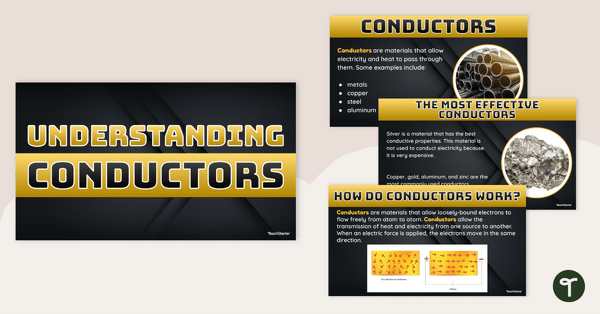
Understanding Conductors Teaching Slides
Teach your students about the basics of conductors with this 17-slide teaching presentation.
- Plus Plan

Conductors and Insulators Teaching Slides
Teach your students about insulators and conductors of thermal and electrical energy with this set of teaching slides.
- Plus Plan
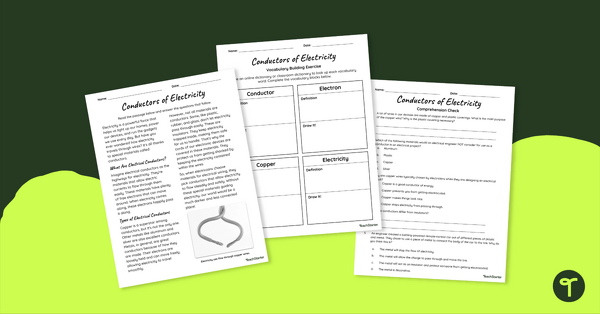
Conductors of Electricity Reading Comprehension Worksheet
Challenge your students to show what they know about electrical conductors with this reading comprehension worksheet.
- Plus Plan
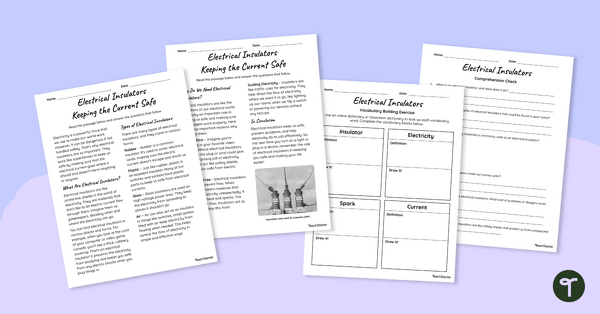
Electrical Insulators Reading Comprehension Worksheet
Discover the shockingly interesting world of electrical insulators with our downloadable reading comprehension worksheet.
- Plus Plan
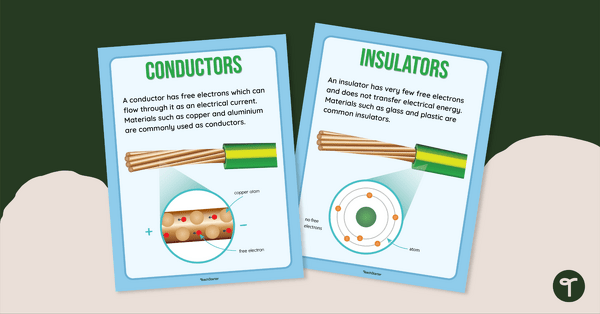
Insulators and Conductors Poster Set
Teach your students about the characteristics of insulators and conductors with this set of science posters for the classroom.
- Plus Plan
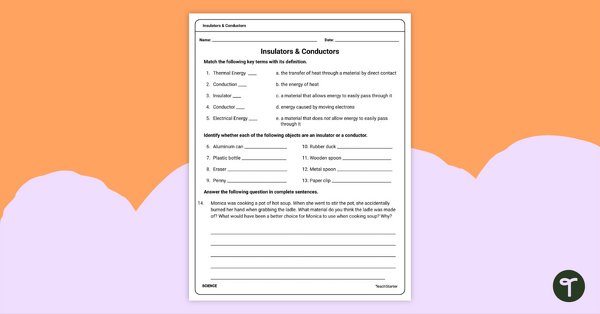
Conductors and Insulators Worksheet
Use this insulators and conductors worksheet with your students to practice identifying the characteristics of thermal and electrical energy.
- Plus Plan
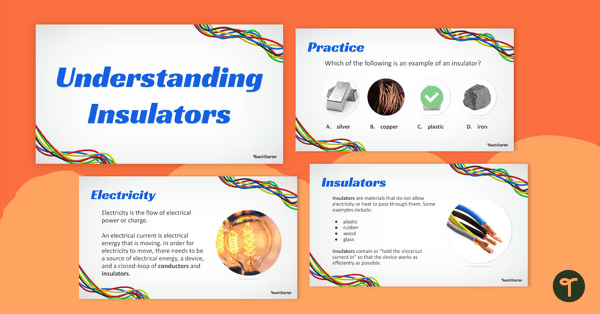
Understanding Insulators Teaching Slides
Teach your students about electrical and thermal insulators with this teaching presentation.
- Free Plan
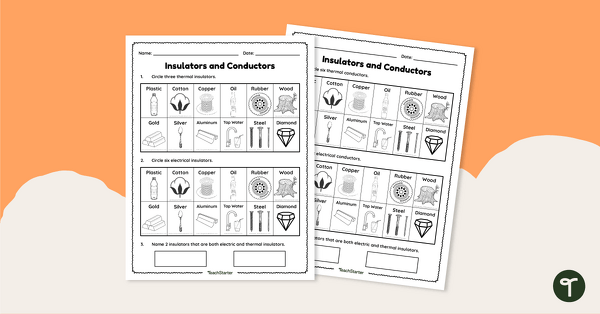
Insulators and Conductors Worksheet
Identify different insulators and conductors of thermal and electrical energy with this worksheet.
- Free Plan
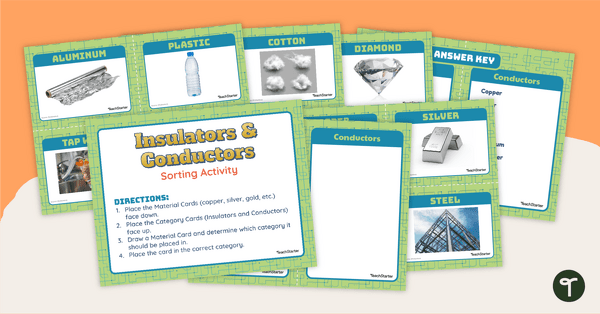
Insulators & Conductors Sorting Activity
Distinguish between insulators and conductors with a picture-based sorting activity.
- Plus Plan
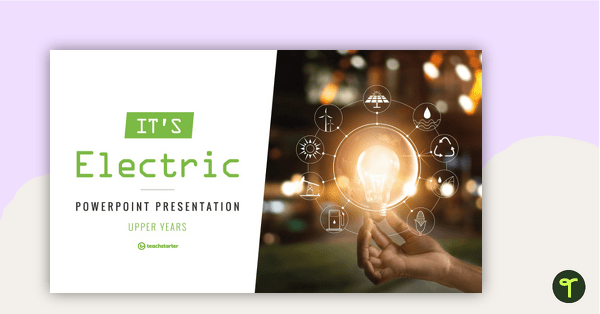
It's Electric! - PowerPoint Presentation
Teach your students about electricity with this editable 23-slide teaching PowerPoint.
- Plus Plan
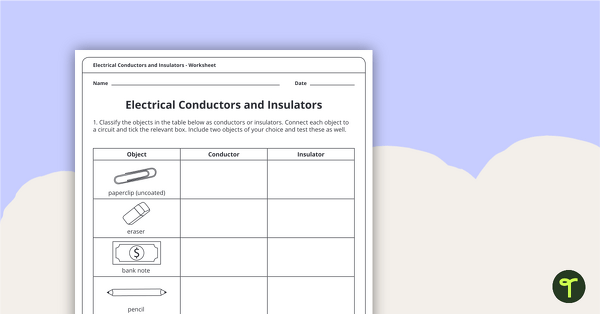
Electrical Conductors and Insulators Worksheet
Explore electrical conductors and insulators with this 2-page worksheet.